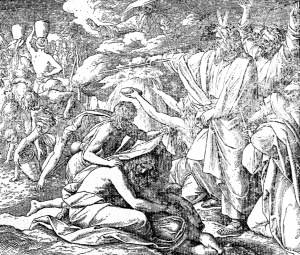 After crossing the Red Sea, the Israelites came to a desert. Through it they wandered three days. They became very thirsty, for there was no water anywhere.
After crossing the Red Sea, the Israelites came to a desert. Through it they wandered three days. They became very thirsty, for there was no water anywhere. After crossing the Red Sea, the Israelites came to a desert. Through it they wandered three days. They became very thirsty, for there was no water anywhere.
After crossing the Red Sea, the Israelites came to a desert. Through it they wandered three days. They became very thirsty, for there was no water anywhere.
At last the Israelites arrived at Mara. But here the water was so bitter that they could not drink. They blamed Moses angrily for their hardships. "What shall we drink?" they asked him.
Moses pray to God, Who showed him a tree. "If you cast the tree into the water, the people can drink, for the water will become sweet," God said.
Moses took the tree and threw it into the bitter water of Mara. Immediately the water turned sweet, and the Children of Israel could drink.
After some time the Israelites had no more food. They had eaten up all the food they had brought out of Egypt. Again they murmured against Moses, "Why did we leave Egypt? It would have been better if we had stayed, for there we could eat. Here we shall all die of hunger."
Then God spoke to Moses, "Tell the people that I will send them meat in the evening and bread in the morning. Then they may eat, and know that I am watching over them."
That evening many birds came. The people caught them and ate. In the morning the ground was covered with small white seeds. The Israelites called these seeds manna, and gathered them for food.
Moses said, "This is the bread which the Lord has given you to eat. Gather as much as you need for the day."
The Israelites obeyed. What was left on the ground melted when the sun arose.
On the sixth day Moses said, "Gather today enough to last you two days. Tomorrow, the seventh day, is holy, and you cannot gather manna." On that day manna did not fall. In this way God showed that His day must be kept holy.
God sent the Israelites manna for forty years in the wilderness, until they reached the borders of Chanaan.
Manna was a type of the Eucharistic Bread, the Body and Blood of Our Lord, which comes from heaven to feed our souls during the time of our mortal pilgrimage till we come at last to our eternal home, Heaven, the true land of promise.
- from My Bible History in Pictures, by Bishop Louis LaRavoire Morrow, D.D., 1934; it has the Imprimatur of Archbishop Michael J O'Doherty of Manila, Philippines